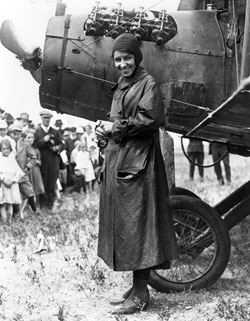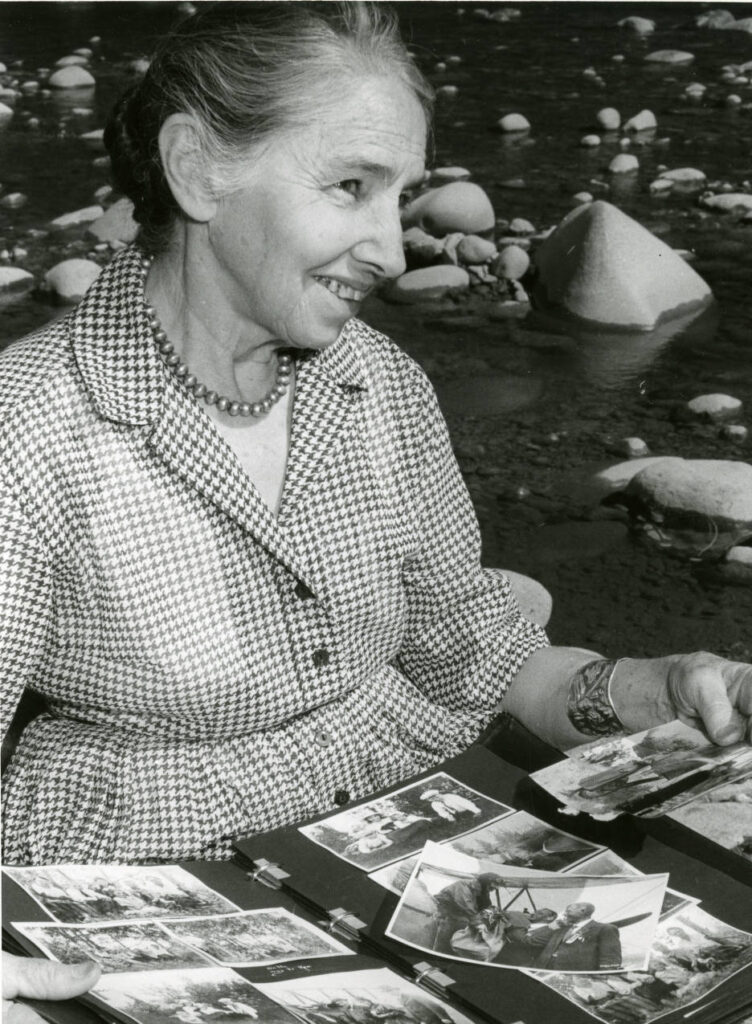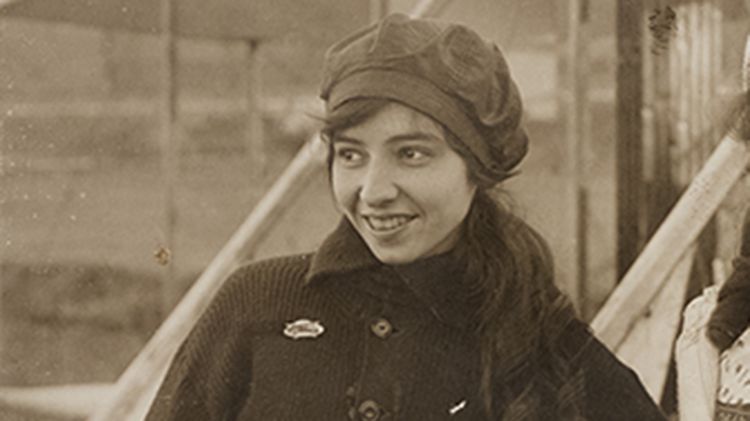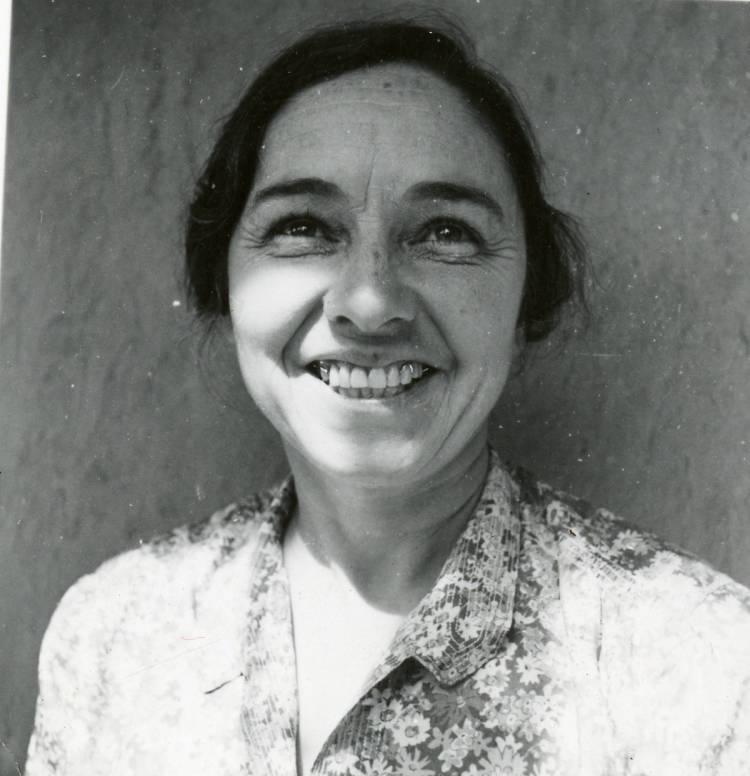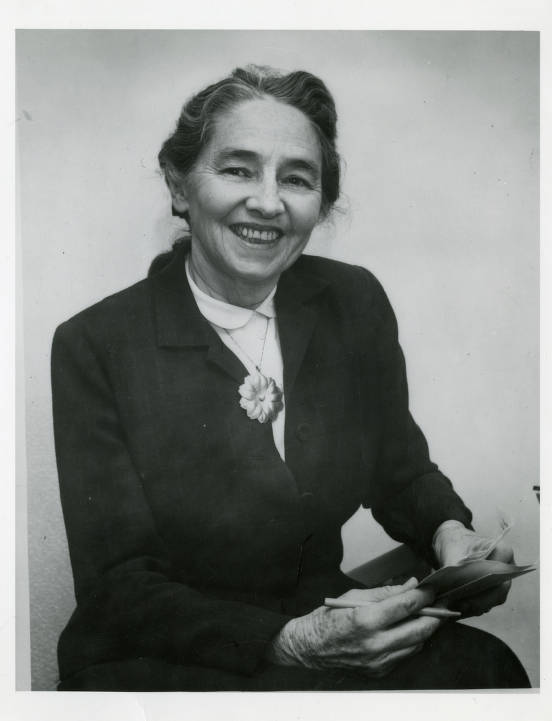Katherine Stinson Otero, the “Flying Schoolgirl.”
Katherine Stinson Otero, the “Flying Schoolgirl”
1891 - 1977
Santa Fe County
One of the first American women to earn a pilot’s license and the first female skywriter, she marveled spectators, helped found the Stinson Aviation Company, designed aircraft, and operated a flight school. After setting aviation records, she went on to a successful career designing Santa Fe homes.
Katherine Stinson Otero was the fourth American woman to earn a pilot’s license and the first female skywriter. She overcame pioneering aviator Max Lillie’s reluctance to teach her to fly, and became the “Flying Schoolgirl,” nicknamed for her youthful looks, small stature, and derring-do. Katherine marveled spectators, rolling her plane, skywriting at night with flares attached to its wings, and maneuvering risky loop-the-loops. With her family, she founded the Stinson Aviation Company, designed aircraft, and operated a flight school. She was the first aviatrix to fly in Asia and set a record in 1917 for the longest West Coast solo flight.
The military twice denied her permission to fly in World War I, although she was already flying a U.S. mail carrier. Instead she drove an ambulance for the French Red Cross. Katherine contracted tuberculosis and sought treatment in Santa Fe where she embarked on a new career designing notable Spanish Pueblo Revival-style homes. Her clients included Manhattan Project gatekeeper Dorothy McKibbin. Katherine married airman and future judge, Miguel Otero, Jr., and the couple remained in Santa Fe until their deaths. They are buried together at Santa Fe National Cemetery.
Katherine Stinson was born on February 14, 1891 in Fort Payne, Alabama, to Emma Beaver and Edward Stinson. She planned to study piano, but reading stories about early pilots in the newspapers and a balloon ride in Kansas City inspired her to become a pilot. In 1912, she enrolled in a flight school offered by Lillie Aviation Company in Chicago, where she convinced the owner, a Swedish man pilot named Mack Liljestrand—also known as Max Lillie—to overcome his reluctance to teach a woman to fly. On her first solo flight at the school, when the plane’s engine stopped, she was able to land the plane safely. On July 24, 1912, age 21, Stinson became the fourth American woman to receive her pilot’s license. Because of her young age, newspapers began referring to her as the “Flying Schoolgirl.”
Katherine Stinson’s interest in aviation was shared with her three younger siblings, Eddie, Marjorie, and Jack. Her sister Marjorie became the ninth woman in the country to earn a pilot’s license. Eddie received his license and founded the Stinson Aircraft Company in Ohio in 1920, which designed and built new planes, including the Stinson SB-1 Detroiter, Stinson SM-1 Detroiter, Stinson SM-2 Junior, and several others. In the years before World War I, Katherine, Marjorie, and Eddie, like many other pilots, used their skills to help train military pilots from both the United States and Canada.
Eddie, who became a well-known pilot himself, died flying a plane on a demonstration flight in Chicago in 1932. After his death, the family incorporated the Stinson Aircraft Company and began building their own aircraft. In 1915, the family opened the Stinson School of Flying at what is now Stinson Municipal Airport in San Antonio.
Katherine Stinson toured during this time, performing in barnstorming shows at state fairs and other exhibitions across the country, often in her renovated Wright aircraft. She flew upside down and performed repeated loops, sometimes as many as twelve. In some performances, she flew at night, with flares and fireworks attached to wings. During this time, she also became the first woman skywriter. As she told an interviewer in 1960: “I had the plane all wired for that, and I could start it with an electric switch on the plane, either one or all of them. One of these planes I tried—Mr. Pickens, who was directing and managing the thing for me said, ‘No one’s tried writing,’ so I said, ‘I might try writing.’ I used the plane and these fireworks things—they made special things—so you could get a very good idea, keep track of it, just watching the plane over and over. Sometimes we’d do two or three loops or whatever we had enough fireworks for.” For her first skywriting effort, she spelled the word CAL, for California, as the writing was done in a field outside Los Angeles.
In 1916, Stinson traveled to Canada and made exhibition flights in Calgary. In an oral history, she recalled an exhibition before a large crowd in bad weather. Her open cockpit plane made for an unusual flight: “So anyway, I got in the plane, and had the motor running, and we didn’t know whether it would hold up. I’d never flown in the rain. It sounds so silly, now. Rains are quite a different proposition now. So anyway, I went up and made my flight, and flew all around so that the people could see that the plane was up in the air. But it was the strangest sensation. The rain in your face is blown back by the propeller, and it’s just like knives cutting you. It didn’t cut, but it really was a very strange feeling, the wind and so forth.”
For five months between 1916 and 1917, she visited Japan and China making exhibition flights, the first woman to do so. She took two planes on the trip—a Partridge biplane and a Laird’s Boneshaker—as a backup in case one crashed. After a flight over the city of Yokohama, the mayor wrote to her, “The aerial flights which you have just given in the city of Yokohama today were most brilliant and clever.” A video of Stinson boarding her plane can be viewed online at: https://www.youtube.com/watch?v=sLv1zeA2aEQ.
In 1917, she flew from Buffalo, New York to Washington, DC in a Curtiss Jenny JN-4D, stopping in small cities along the way to publicize and fundraise for the Red Cross. In her “Call to Knit” Flight, she flew from Chicago to New York, dropping postcards that read:
WOMEN OF AMERICA—A CALL TO KNIT
I am flying from Chicago to New York to bring home to you a Red Cross message. May it in turn fly straight to your hearts. One million and a half each of knitted sweaters, mufflers, socks and wristlets are needed by the American Red Cross. You are asked to make them at once.
Knit for Our Soldiers
Knit for the Soldiers of our Allies
Knit for the Destitute of Belgium and France
The Red Cross calls to you to act. Ready now, with your needles. Let’s fill this
order before our boys, their allies and the destitute civilians suffer from the cold.
Get in touch with the nearest Red Cross Chapter and KNIT, KNIT, KNIT
-Katherine Stinson
Later that year, she set a new record for non-stop flying by traveling 610 miles from San Diego to San Francisco. Soon after, the government stopped all civilian flights with the outbreak of the war. This meant the end of the Stinson School in San Antonio when the city took over the airfield. In early January of 1917, she sent a telegram to the State Department reading, “Rumored war with Germany. Offer services -Katherine Stinson.” But the government did not allow women to fly in the war effort. She instead chose to make a difference on the ground, becoming an ambulance driver for the Red Cross in France. “I learned to drive a Ford car in the streets of Paris, being taught by French taxi drivers in French, and I didn’t know any French, and they—I would get it into the wrong lane and they didn’t like it one little bit.”
Shortly after the war, Stinson learned that in the performance of those duties, she had contracted tuberculosis. The diagnosis ended her flying career but led her to another calling.
Tuberculosis treatment at the time required patients to be sequestered from the general population, exposed to long periods of sunlight and fresh air, and offered a strict diet. Given the dry climate in New Mexico, the state had a number of tuberculosis sanatoriums in the early part of the twentieth century to treat patients. In 1920, Katherine Stinson moved to the state—and she was in good company: “Thousands of people flocked to New Mexico from 1880 through 1940 seeking a cure for tuberculosis, the leading cause of death in America. These lungers, as they were called, included artists such as Will Schuster and Carlos Vierra, who ‘came to heal and stayed to paint.’ Bronson Cutting, brought to Santa Fe on a stretcher in 1910, became the publisher of the Santa Fe New Mexican and a powerful U.S. senator. Others included William R. Lovelace and Edgar T. Lassetter, founders of the Lovelace Clinic, as well as Senator Clinton P. Anderson, poet Alice Corbin Henderson, architect John Gaw Meem, aviator Katherine Stinson, and Dorothy McKibbin, gatekeeper for the Manhattan Project—to name just a few.”
Stinson sought treatment at the Sunmount Sanitarium in Santa Fe, which had special cottages equipped with small screened sleeping porches and sponsored concerts, lectures, horseback rides, and excursions to nearby Pueblos. Her time at Sunmount turned out to be the impetus of an entirely new second career. After she met renowned architect John Gaw Meem, also a patient, she became successful and prominent in the design field without being part of a firm or being registered in the state. Known for her sense of New Mexico style, use of local materials and customs, and understanding of space, she designed the Gay-Wagner House in Santa Fe, as well as Dorothy McKibbin’s house in Santa Fe, now on the National Register of Historic Places.
In 1927, Katherine married Miguel A. Otero, a fellow pilot who served in World War 1, and the son of former New Mexico governor Miguel Otero, Sr.
In 1929, Stinson was invited to join the “Ninety-Nines,” a group of women aviators formed that year with Amelia Earhart as the first president. Dedicated to helping women pilots, the organization continues its work today.
In 1936, the buildings and airfield of the former Stinson Flying School were renamed the Stinson Municipal Airport.
Among many honors and awards she received in her lifetime, Stinson served as the New Mexico Delegate to the “National Conference for Development of Commercial Aviation,” held in St. Joseph, Missouri, June 6th and 7th, 1927. She was awarded the General Federation of Women’s Clubs “Scroll of Honor” (May 19, 1944), “In recognition of her outstanding service in the field of aviation and of her leadership among the women of the world.” The National Aeronautic Association of the U.S.A. (October 14, 1953) issued her “This appreciation and recognition of real pioneer efforts which have contributed so importantly to the continuing progress of aeronautics during the first half-century since Kitty Hawk.” The National Aeronautic Association of the U.S. A. (October 21, 1969) granted her the “Elder Statesman of Aviation” award “In recognition of her significant and his (sic) demonstrated qualities of patriotism, integrity, and moral courage worthy of emulation.”
Katherine Stinson Otero passed away in Santa Fe on July 8, 1977 at age 86. As a summary of her life, an article in the Santa Fe New Mexican on March 17, 1928, serves well: “A trail-blazer of the heavens, the first night flier, one of the first if not the pioneer sky-writer and fireworks stutter. Katherine Stinson electrified the world from New York to Tokyo and Peking with her marvelous winged feats, and medals and gifts were showered on her by four nations and countless cities and individuals.”
Sources:
Awards, marriage certificate, medals and other items of recognition from “Otero-Stinson Family Papers, 1843-1985,” MSS 506 BC, Center for Southwest Research, University of New Mexico, Albuquerque.
Keffeler, Christine A. “Stinson, Katherine.” Handbook of Texas Online, https://tshaonline.org/handbook/online/articles/fst97 , accessed September 10, 2016.
Lewis, Nancy Owen. “Seeking a Cure, Transforming New Mexico: The Lungers and Their Legacy.” Office of the State Historian,
http://newmexicohistory.org/people/lungers-and-their-legacy , accessed September 9, 2016.
Lebow, Eileen F. Before Amelia: Women Pilots in the Early Days of Aviation. Dulles, VA: Potomac Books, 2003.
Lufkin, Agnesa. “The Gay-Wagner House: Hand-made Space.” New Mexico
Architecture, July-August 1978.
Pratt, Boyd C. “A Brief History of the Practice of Architecture in New Mexico.” New Mexico Architecture, Vol. 30, No. 6, Nov-Dec, 1989.
Stinson Municipal Airport. “Still Flying High” (historical pamphlet) n.p., n.d. From Stinson, Katherine vertical file, Center for Southwest Research, University of New Mexico, Albuquerque.
Underwood, John. “Stinson Chronology.” n.p., n.d. From “Otero-Stinson Family Papers, 1843-1985.” MSS 506 BC, Box 7, Folder 13, Center for Southwest Research, University of New Mexico, Albuquerque.
Wiedeman, Paul. “Inside Adobe Walls: Stinson Compound” The Santa Fe New
Mexican, May 4, 2003.
“Oral Interview with Katherine Stinson,” Columbia University, taped July
1960, typed transcript. “Otero-Stinson Family Papers, 1843-1985,” MSS 506 BC, Box 7, folder 6, Center for Southwest Research, University of New Mexico, Albuquerque
.
“Leading New Mexico Women Ably Represent Governor of the State.” Santa Fe New Mexican, March 17, 1928.
“Our History.” The Ninety-Nines, http://www.https://www.ninety-nines.org/our-history.htm , accessed September 17, 2016.
Simantis, Dennis, “The Stinsons—High Family Values.”
https://simanaitissays.com/2015/07/05/the-stinsons-high-family-values/ , accessed November 14, 2016.
“Katherine Stinson Otero Drawings and Plans.” Center for Southwest Research, University Libraries, UNM,
https://beta.worldcat.org/archivegrid/data/144610579 , accessed December 27, 2016.
Directions:
Katherine Stinson Otero, the “Flying Schoolgirl”
Santa Fe County
Activist | Artist | Entrepreneur |
Statehood (1912 - present) | Territorial Period (1848 - 1912) |
North Central



